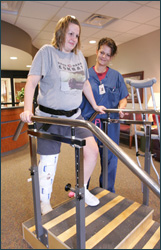more information
on this subject |
 |
At Home Care & Activity
You are an important part of
the
success of your surgery. Your success greatly
depends
on how well you follow your
surgeon's instructions about
home care
during the weeks
immediately following your
surgery. Prior to your
discharge from
the
INSTITUTE FOR
ORTHOPAEDIC SURGERY (IOS)
and to help you in
home
recovery, you (and a family
member) will receive a personalized
plan of
care/instructions to follow while recuperating at home. If you are going to an
extended care facility, your caregivers at the new facility will also receive
your discharge plan.
This detailed plan will contain instructions about your activity level, diet, how
to care for incisions/dressings including when you can shower or bathe,
medication regimen, including pain medications and any need for laxatives,
plus the important signs and symptoms to watch for that might indicate
an infection or complication.
In addition to your discharge plan and home instructions, you will receive
an appointment with your surgeon for follow-up care to make sure you are
healing well and to remove any sutures or staples. You will also receive
a physical therapy appointment, as indicated for your type of surgery.
While at home, if you have questions or concerns regarding your post-surgery condition, you can call the INSTITUTE FOR ORTHOPAEDIC SURGERY at 419-224-7586, 24 hours a day, seven-days-a-week. Our professional staff will be happy to serve you, answer your questions, and/or give you directions on contacting your surgeon.
Deep Vein Thrombosis Educational Material
The following is information about blood clots that can form and result in deep vein thrombosis and pulmonary embolus. A person's chances of developing a blood clot increases after a surgical procedure. This information is provided for your health safety and will include the complications, symptoms, risk factors and preventive measures.
Complications
Blood clots can develop in the veins in the lower leg and thigh when blood flow is slowed down due to long periods of not moving around thus, causing reduced blood flow. This is called deep vein thrombosis (DVT). When a blood clot (thrombus) breaks off and travels it is called an embolism. A blood clot in the lungs is called a pulmonary embolism (PE) and can be life threatening.
Symptoms of Deep Vein Thrombosis (DVT)
DVT can be difficult to diagnose because only 50% of patients have symptoms. When there are symptoms they include:
- Pain while walking, typically in the ball of the foot and/or calf.
- Leg swelling
- Leg pressure
- Leg fullness
Contact your doctor or seek medical attention immediately.
Symptoms of Pulmonary Embolism (PE)
The most common symptoms of PE are:
- Shortness of breath
- Difficulty breathing
- Feeling of anxiety
- Chest pain that worsens with a deep breath, cough or chest movement.
- Coughing up blood
Seek emergency medical attention immediately.
Risk Factors
These are some factors (not a complete list) that will increase a person's chances of developing a blood clot:
- Major surgery, such as hip or knee replacement
- Surgery with general anesthesia lasting longer than 30 minutes
- Previous history of blood clots
- Age over 40 years old
- Smoking
- Being overweight
- Limited movement
- Dehydration
- Family history of clotting problems
- Cancer
Prevention
Methods to prevent blood clots include:
- Walking and gentle exercise
- Compression stockings (TED hose)
- Sequential Compression Devices (SCDs)
- Medicines that prevent blood clots
- Avoid sitting or not moving legs for long periods of time
- Keep legs uncrossed
- Drink plenty of water
- Do not have more than two alcoholic drinks per day
- If traveling by car for more than 3 or 4 hours, stop every hour to take a short walk or exercise legs.
Types of Walking and Gentle Exercise
Using the leg muscles helps the blood in the leg veins return to the heart.
- Keeping the feet up to help the blood flow through the leg veins
- Do foot exercises, such as toe curls and foot flexion and extension.
- Go for short walks, if possible
- Avoid crossing your legs and ankles when you sit
- Follow the exercise program you are given
After Your Operation – Preventing Constipation
Management is necessary to prevent constipation caused by your prescription pain medication and your decrease in activity. Many steps may be taken to establish and maintain a regular elimination routine.
Importance should first focus on dietary modifications.
- Drink at least eight to ten glasses of water daily.
- Eat high fiber whole grain cereals, breads and fresh fruit.
- Avoid pastries, pasta and ice cream.
An over-the-counter laxative, taken as directed may also be required during your recovery period. Recommended laxatives are: Senokot, Colace and Milk of Magnesia. The overall goal is to have a bowel movement closest to your normal routine before your surgery. If at any time your dosage of prescription pain medication is increased or decreased you will also need to change the dosage of your laxative. Bulk laxatives are to be avoided because they contain psyllium. Examples of laxative to avoid are Fiberall, Metamucil, Citrucel and Fibercon. If you do not have a bowel movement within 48 hours after starting the laxative, two tablespoons of Milk of Magnesia after breakfast may be added, while continuing to take the laxative.
If you do not have a bowel movement within three to four days after starting the laxative and using the Milk of Magnesia, please call your physician for further instructions.
Once your bowel movements have returned to normal, start reducing the amount of laxative you are taking until none is needed.
Please Note: temporary constipation related to your pain medication should be the only time you continue to use laxatives because bowel dependency can occur.
...back to Post-Op Care


